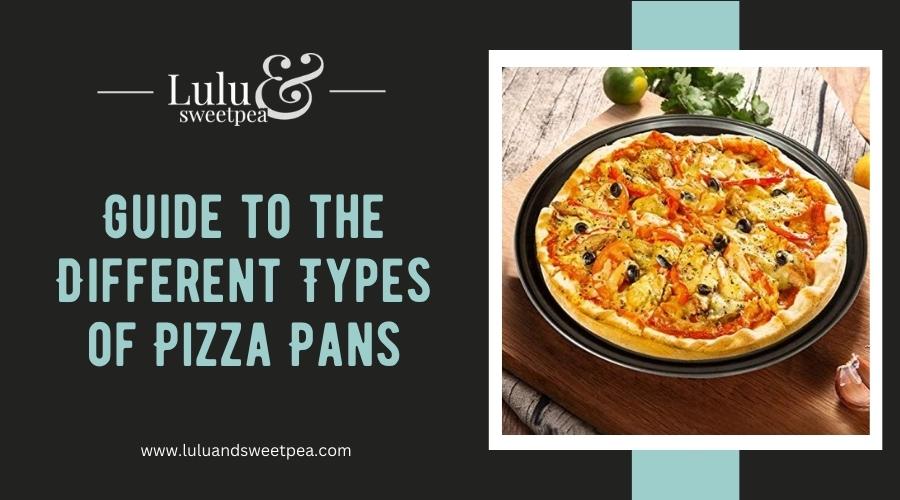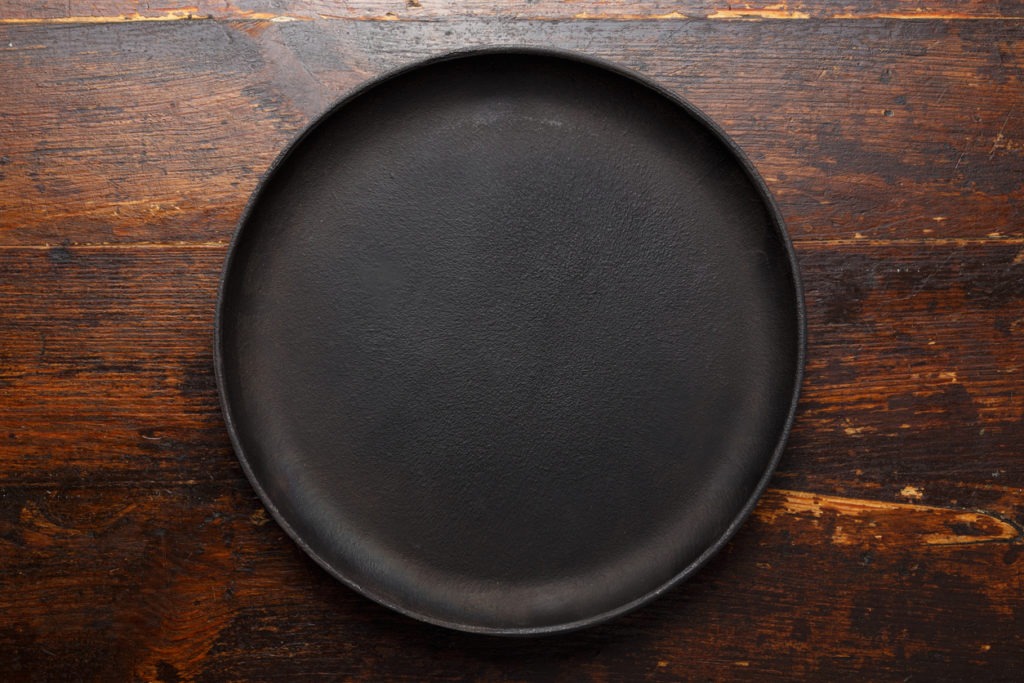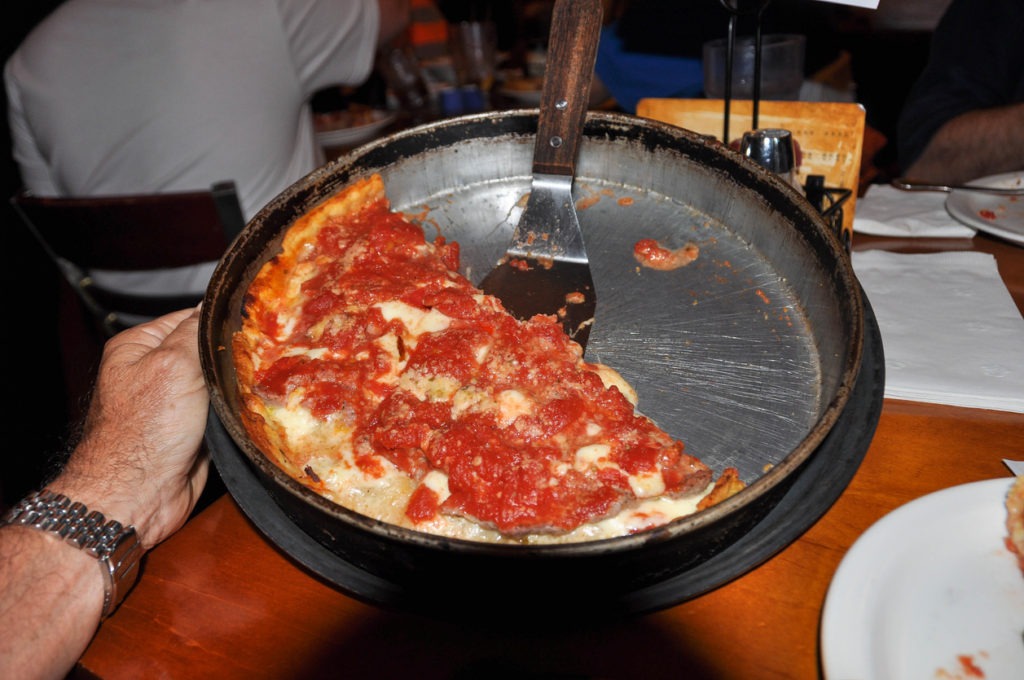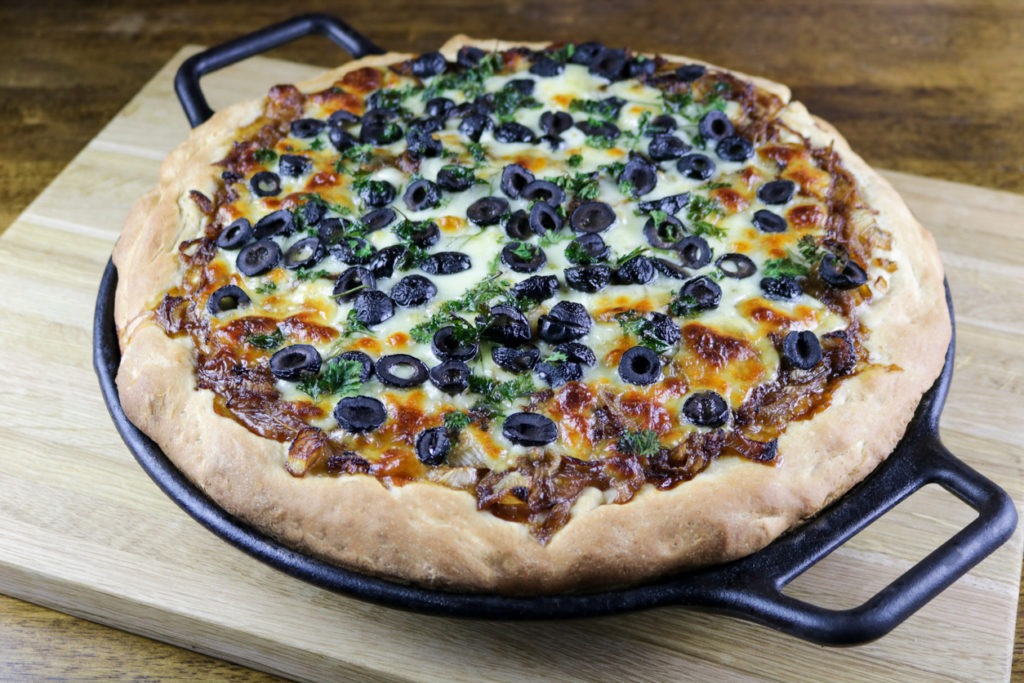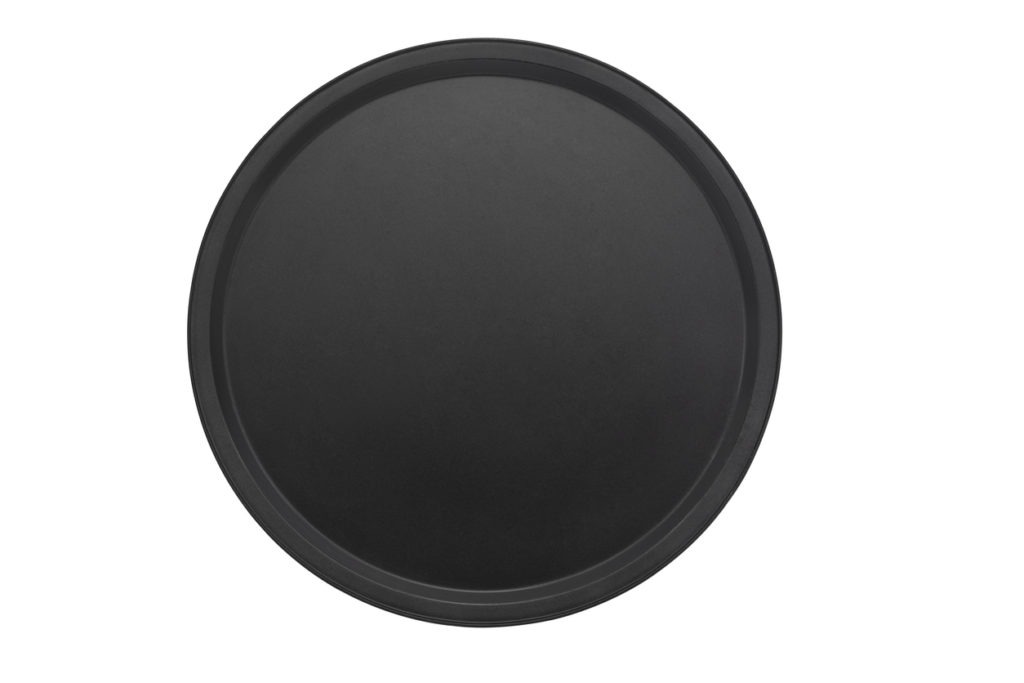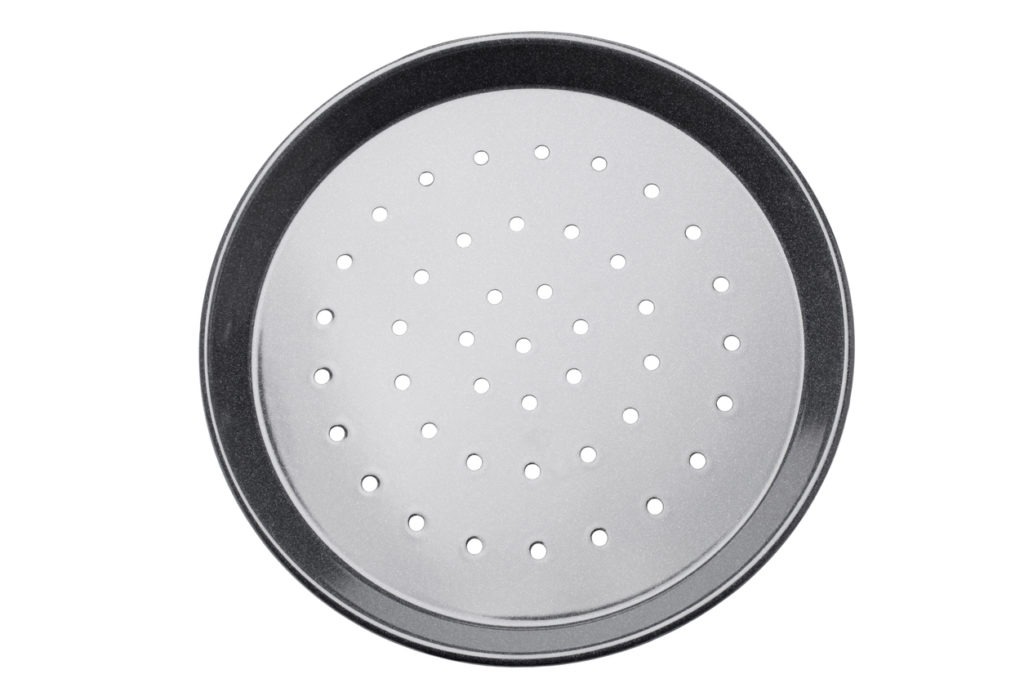Pizza has become so popular that it is served at many cafes, pizzerias, restaurants, food trucks, and bars. It’s a tasty, filling treat that is very convenient and enjoyable to eat – making it a filling snack or meal like lunch or dinner. Leftover pizzas from last night are often reheated as breakfast, too!
If you like to try making your own pizza at home or start your own pizzeria, a pizza pan is an essential tool to help you get started with pizza baking. A thorough understanding of the different varieties of pizza pans is needed to make a decent pizza and achieve the desired results.
Different Types of Pizza Pans
Pizza pans come in different types, each delivering a distinct flavor. The type of pizza you want to create dictates the pan you’ll need. The thickness, surface, and design all have an effect on the finished product.
1. Regular (coupe) pizza pan
Coupe or regular pizza pan is the most common form of pizza pan in the market. It has a flat, smooth shape with slightly raised sides that is ideal for oven-to-table pizza serving. Usually, this type of pan is made of aluminum or hard-coated anodized aluminum for extra durability.
This is the ideal pan to use if you want a pizza that has a soft and doughy crust. It’s simple to use – just assemble your pizza pie right on the baking sheet, then bake it. Because there are no holes for corn flour or oil to fall through, this pizza pan is better to use when serving pizza on a dinner table. And when it comes to baking at home, this type of pan might be sufficient for your pizza-cooking needs.
2. Deep dish pizza pan
Deep dish pans are very distinctive from regular pizza pans because of their high side walls. If you need to cook deep-dish pizza, a deep-dish pan in a round or square shape must be used. They are available in different materials: nonstick, aluminum, and tin-plated stainless steel. Also, deep-dish pizza pans can be used in any oven for cooking pizza.
3. Pizza screens or disks
Pizza screens are made up of mesh, which helps the pizza bake faster. It allows for easy heat transfer through the mesh to the pizza dough. Its ability to transfer heat both on top and at the bottom of the pizza dough makes it perfect for achieving crispy and non-soggy crust for thin-crust pizzas.
4. Pizza stones
The biggest advantage of using a pizza stone over a regular pizza pan is that it can produce a crispier crust. Ceramic or cordierite pizza stones use the stone’s porous surface to absorb extra moisture from the dough, making the crust crispier as it bakes. It stimulates the stone oven or brick-oven method of making pizza. Metal pans are typically not recommended, given the high temperatures needed to cook a brick-oven pizza. Pizza stones also allow you to bake tasty, crispy pizza on a regular grill or oven.
5. Cast iron pizza pans
Cast iron pizza pans allow for versatile pizza cooking. The cast iron pan can be used in the oven, on the grill, under the broiler, or even on top of the stove. This pan comes with a raised border to help keep the crust’s edges in place, and it also often comes with handles on both sides. Cast iron pans are usually pretty heavy, but they are great for baking pizza.
6. Wide-rim pizza pans
Wide-rim pizza pans look much like regular or coupe pizza pans, except for the wider rim to make handling and slicing pizza easier since they offer more room. It’s most often used for food service and preparation. Aluminum wide-rim pizza pans can be used for baking in the oven and serving pizza.
7. Cutter pizza pans
Cutter pizza pans come with higher, curved sides to help lift the crust’s edges. Because of their form, these pans are ideal for handling rolled or sheeted pizza dough. This type of pizza pan is ideally used in a professional oven.
Pizza Pan Surface Styles
The type of pan and its thickness have an impact on the style of the crust, but the pan surface also has an effect on what the pizza crust will be like. It also affects the flavor of the pizza. As the pizza dough cooks inside the oven, the pan surface can influence the level of airflow and heat dispersion, so if you use a pizza pan with holes, the crust will be crispier than if you use one without holes.
1. Solid pizza pans
Solid, non-perforated pizza pans have no holes or nibs. As a result, the crust of the pizza cooked in it will be doughy because it takes a longer time for the heat to permeate through the solid pan. It’s great for making a soft and chewy pizza. Besides pizza, this pie can also be used for making pies, cakes, roasts, and other baked goods.
2. Nibbed pizza pans
A pizza pan with nibs has raised bumps at the surface of the pizza pan to help with overall airflow underneath the crust. With the nibs, the grease from the dough remains in the pan rather than being absorbed back into the crust during cooking or sitting. A nibbed pizza pan also speeds up the baking time for pizza dough, making the crust a bit crispier than a typical solid pan.
3. Perforated pizza pans
A perforated pizza pan has holes, which allow heat to directly hit the crust. It helps the pizza cook faster and makes the crust crispier. The perforations in the pizza pan enable water to evaporate while the crust is resting, so it won’t get drawn back to it and reduce moisture.
4. Super perforated pizza pans
Like the perforated pizza pans, this type of pan has holes but is bigger. It allows more air to hit the crust, making baking time even shorter and the crust much crispier.
Pizza Pan Coatings
The coatings of a pizza pan can also impact how your pizza cooks. It can also determine how you will clean up your pan. Here are some types of pizza pans according to their coating:
Dark vs. Light-Coated Pizza Pans
Dark-coated pans can speed up cooking because darker finishes retain more heat, accelerating baking time. Meanwhile, lighter silver pans slow baking time because it reflects heat rather than absorb it.
Anodized hard-coated pizza pans
Anodized hard-coated pizza pans come with a corrosion-resistant, anodic oxide treatment that does not flake. These pans come with a black finish, so you can expect your pizza to cook faster.
Silicone glaze pans
Silicone glaze pans come with silicone glaze on top of the hard anodized coating. The silicone prevents sticking, which reduces the amount of oil needed to coat the pan by almost 50 percent. Since it is pre-coated, a silicone glaze pizza pan doesn’t need to be seasoned before first use.
Uncoated glaze pans
Pizza pans that are uncoated are the lightest in color and need to cook longer in the oven because it reflects heat. It also needs to be seasoned first before use.
What to Consider When Choosing a Pizza Pan
The frequency of cooking and your goals are essential considerations when cooking a pizza pan. You may have uncoated pans in your baking arsenal, but if you plan to cook more pizza in the future, it’s best to invest in dark metal pans because they retain more heat. To avoid warping at high temperatures, using pans with a thick surface is recommended.
Here are other things you might want to consider before buying a pizza pan:
1. Material
Cooking time is determined by how long it takes a pizza pan to cool. And different materials yield varying outcomes.
For instance, cast iron and stainless steel are the most common materials used in making pizza pans. Stainless steel is easier to maintain and clean, but because of the fast rate of heat conduction, it’s more prone to generate scorched pizzas.
On the other hand, cast iron pans need to be properly and regularly seasoned to maintain their nonstick properties. These pans are extremely sturdy and are less likely to burn pizzas.
2. Handles
Should you need a pizza pan with a handle, choose one that has strong ones. If you go and take your baked pizza out of the oven and one handle snaps, all your hard work is wasted on the floor. For better security, get pizza pans with aluminum handles.
3. Edges
How high or low the edge might be is based on your personal preference. A deep-dish pizza must be cooked in a deep dish pan or in a pan that allows for a stuffed crust.
How to Season a Pizza Pan
Most pizza pans – including those with nonstick coating, silicone glazed, hard-coated and tin-plated pans – need to be seasoned first before use to ensure that the pizza would not stick and to lengthen its lifespan. If you fail to season your pan, it might get scratched while you’re trying to remove the remaining pizza dough or crust stuck on it. Here’s how to season a pizza pan:
- Preheat oven to normal baking temperature, which is somewhere between 450 to 500 degrees Fahrenheit.
- Wash your pan by hand in warm, soapy water.
- Pat the pizza pan dry using a soft kitchen towel or paper towel.
- Place the pan in the oven to let it dry completely and warm it up.
- Remove the pan from the oven and cover both sides with a thin layer of shortening oil.
- Cover the baking sheet with aluminum foil and put it on the bottom rack of the oven.
- Place the pan back into the oven on the rack above the sheet pan.
- Bake for 15 minutes, then remove it from the oven and let it cool.
- Wipe off any excess oil with a clean cloth.
- Allow the extra oil on the pan’s surface to prevent the pizza crust from sticking.
